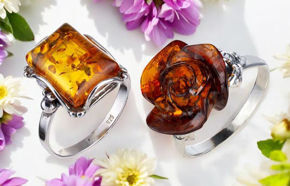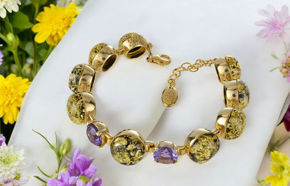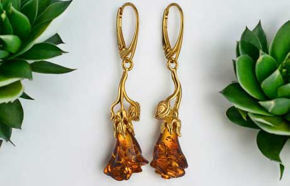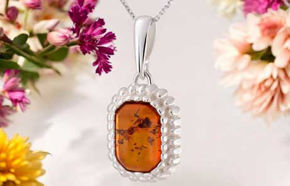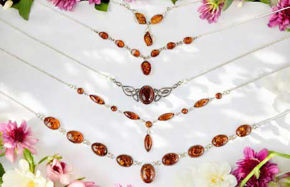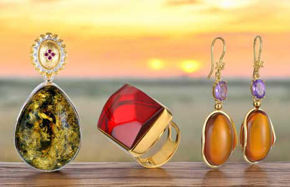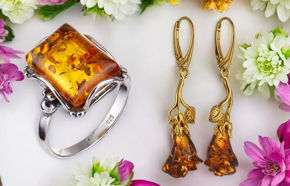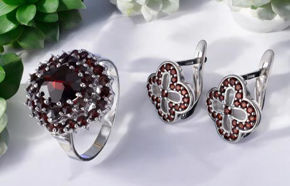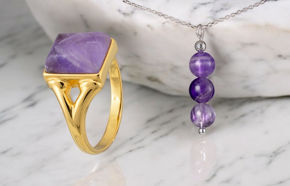Amber, if you are not aware, is a soft resin stone substance dating back to prehistoric days when it was first noticed oozing from the coniferous trees, trees producing cones, later known as pine trees, in the Baltic region of what is today Poland, Lithuania, and Russia. This Baltic amber was later used by the ancient civilizations in creating ornamental jewelry when the trees that produced this ‘sticky’ yellow-orange substance fell into the sea during storms, was buried under the sands of the sea, the amber substance fossilized, and eventually floated back to shore to be discovered anew in all its golden yellow-orange glory!
While the oldest and largest supplies of amber continue to be Baltic amber, amber has also been discovered in five of the seven continents around the world: North America, Europe, Africa, Australia and Asia. When amber is said to have inclusions, it refers to the fossilized remains of ancient plants, insects, birds, or even dinosaur remains.
Noteworthy Facts:
Not all amber is the same.
- Some discoveries are actually copal a resin substance substantially younger than the minimum age
of amber of ten million years.
- Only Baltic amber contains succinic acid that science has affirmed has therapeutic healing properties for such ailments as heart, respiratory, and arthritic inflammation.
- Without succinic acid, amber is classified as retinite amber from the beds of brown coal.
- Amber from other regions of the world does not always come from pine trees and amber from other regions is not always the yellow-orange color.
- The composition and color of amber in other parts of the world depends on such factors as the tree or plant the amber came from, how old the amber is, the environment that it existed in.
- Historians have been able to deduce early world trade routes through the study of ancient artifacts
made with amber.
- Amber is predominantly found on the European, North American, and Asian continents
North American Amber
Large amber deposits found in Alaska, derived from ancient swamp cypress trees, Arkansas, Aurora, North Carolina, and noteworthy: in Sayreville, New Jersey amber was discovered just a few feet below the earth’s surface. Amber is abundant in the Caribbean island of the Dominican Republic in sand and claystones of the Northern and Eastern Mountain ranges from Hymenaea trees and come in a range of colors with 90 percent of Dominican amber transparent. Individual pieces of Dominican amber hold inclusions of 500 to 1000 ants, flies, fauna, and flora. Amber found in Chiapas, Mexico to the east of the Lacondon jungle and also rich in fossilized insect inclusions. Canadian Amber is primarily found in the area known as Cedar Lake, Manitoba and like the Dominican Republic and Mexico contain many inclusions: flies, arachnids, and other insects. Columbia and Nicaragua located on the North American continent also report amber finds: in Nicaragua along the Caribbean shoreline in sandstones with colors of transparent yellow to red with very few inclusions. In Columbia, copal found at Pena Blanca from the Hymenaea tree.
European Amber
As previously stated, Poland, Lithuania, and Russia provide the valuable succinic amber that is of a yellow-orange color but for that, quite naturally, the continent of Europe is a major source for amber discoveries and
has a large amber museum in Lithuania. Amber found in Italy, Romania, Spain, The Ukraine, in Germany along Baltic coast and Elbe River, Austria, France, and Switzerland. Noteworthy mentions: Sicilian amber found on the banks of the Simetus River and well known by its dark-red colors and blue florescent colors. Romanian amber deposits were found in the banks of the River Buzau, in the East Carpathians with color tone of Romanian amber brownish yellow, red-brown and black. The brownish red colored amber has a fluorescent bluish green reflection. In Northern Spain, amber was found to be of a bluish color. Amber from Austria comes from the Austrian Alps near Golling and Saltzburg in dark brown to black color. Amber from France comes from just outside of Paris near the Olse River. These single pieces have a frosted appearance and with polishing is yellow transparent.
Asian Amber
A 150 kg of Amber from a coal mine in Northwest India in the Gujarat Province that scientists report to be 50 million years old was discovered in Cambay Shale. In Northern Burma, now called Myanmar, amber has been found in clay deposits and coal seams in the Hukong Valley. Amber found in China, in the coal beds of the Guchenzgi formation, near to the city of Fu Shun, province Liaoning. Amber found weighing in at 30kg in a coal seam of the Merit-Pila coalmine in Sarawak, North Borneo, Malaysia. Amber found in Northern Japan, predominantly in the city of Kuji, but also in Mizunami and Chosi. Chosi amber has varied colors while Mizunami amber is dark brown or an intense red. The Kuji amber deposits came from mountainous slopes. Japanese amber is usually cracked due to the seismic tremors and pressure of the depths they were discovered in and within the cracks are quartz crystals. Found in Manila, Philippines: copal, a yet fully ‘ripened’ amber. This Philippine copal is young at one hundred years of age.
South America
No reported finds of Amber on South American continent.
African Amber
The first real amber of Africa found in Ethiopia in Debre, Lebanon, the northern part of Addis Ababa. Inclusions: plant fragments, flying insects, arachnids, and microorganisms. Amber deposits found in Tanzania are older than copal but younger than Baltic amber.
Australian Amber
Amber has washed ashore along with a variety of other resin and pumice on the east shore of Australia in Queensland, Cape York in 1997. Colors were brown, brown-yellow, sometimes red transparent. Many inclusions.
Antarctica Amber
No amber found in Antarctica.

